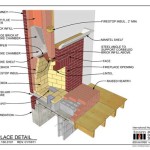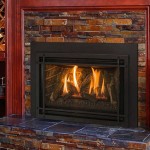Installing Stone Tile Around a Fireplace: A Comprehensive Guide
Installing stone tile around a fireplace can dramatically enhance the aesthetic appeal of a living space, adding a touch of elegance and natural beauty. This project, while achievable for experienced do-it-yourselfers, requires careful planning, meticulous execution, and a thorough understanding of the materials and tools involved. This article provides a detailed guide to the process, outlining the steps necessary for a successful stone tile installation around a fireplace.
Before embarking on the installation, it's crucial to assess the existing fireplace structure. The structural integrity of the fireplace, firebox, and surrounding areas must be sound. Any cracks, crumbling bricks, or other signs of damage should be addressed before proceeding with the tiling project. Depending on the severity of the damage, professional chimney or masonry repair may be necessary. Addressing structural issues early on is essential for safety and longevity.
The substrate, or the surface to which the stone tile will be adhered, is another critical consideration. A clean, level, and structurally sound substrate is vital for proper tile adhesion and a visually pleasing result. Common substrate materials around fireplaces include brick, cement board, and concrete. Each material requires specific preparation techniques, which will be explored in detail later.
Selecting the appropriate stone tile is another important step. Stone tiles come in a wide variety of materials, including slate, granite, marble, travertine, and manufactured stone veneer. Each type has its own unique aesthetic qualities, durability characteristics, and installation requirements. Factors to consider when choosing stone tile include the overall style of the room, the desired level of maintenance, and the budget.
Safety precautions are also paramount. Working with power tools like tile saws and grinders requires proper eye and ear protection. Dust masks are essential when cutting tile to prevent inhalation of harmful silica particles. When working near a fireplace, ensure the area is well-ventilated, and fire extinguishers are readily available.
Preparation is Key: Preparing the Substrate and Gathering Materials
The success of any stone tile installation hinges on thorough preparation. This phase involves preparing the substrate, gathering the necessary materials and tools, and carefully planning the tile layout. Neglecting these steps can lead to costly mistakes and unsatisfactory results.
Preparing the Substrate:
The substrate must be clean, level, and structurally sound. Existing paint or wallpaper must be removed completely. Loose debris, dust, and grease should be scrubbed away with a mild detergent and water. If the substrate is uneven, a self-leveling compound may be necessary to create a smooth surface. Cracks in the substrate should be repaired with a masonry crack filler. For brick substrates, a wire brush can be used to remove loose mortar and dirt. Cement board substrates should be properly screwed or nailed to the framing studs.Gathering Materials:
The following materials are typically required for a stone tile installation around a fireplace:- Stone tiles: Calculate the square footage needed, adding at least 10% for waste due to cuts and breakage.
- Thin-set mortar: Choose a mortar specifically designed for stone tile, considering the type of stone being used.
- Grout: Select a grout color that complements the stone tile.
- Sealer: Apply a sealer specifically formulated for stone to protect it from stains and moisture.
- Backer board: This is optional, but highly recommended for uneven surfaces or if the existing surface is not suitable for tiling.
- Caulk: Purchase caulk to seal the edges and corners.
Gathering Tools:
The following tools are commonly needed for a stone tile installation:- Tile saw: A wet saw is recommended for cutting stone tile accurately.
- Notched trowel: Choose the correct notch size for the size and type of tile being used.
- Grout float: Used to apply grout evenly into the tile joints.
- Grout sponge: Used to clean excess grout from the tile surface.
- Level: Ensures tiles are installed level and plumb.
- Measuring tape: Accurate measurements are essential for a professional-looking installation.
- Pencil: For marking cut lines on the tiles.
- Safety glasses: Protects eyes from dust and debris.
- Dust mask: Prevents inhalation of harmful silica particles.
- Rubber mallet: Used to gently tap tiles into place.
- Spacer: To ensure uniform gap between the tiles.
Planning the Layout:
Before applying any mortar, dry-fit the tiles to determine the best layout. This allows for adjustments and minimizes the number of cuts required. Consider the placement of grout lines and any decorative elements. Mark the location of outlets, switches, or other fixtures that need to be accommodated.The Installation Process: Applying Mortar, Setting Tile, and Grouting
The installation process involves carefully applying the thin-set mortar, setting the stone tiles, and grouting the joints. This phase requires patience, precision, and attention to detail to achieve a professional-looking result.
Applying Mortar:
Using a notched trowel, apply a thin, even layer of thin-set mortar to the prepared substrate. Hold the trowel at a 45-degree angle and apply enough pressure to create consistent ridges. The depth of the notches should match the recommendations of the mortar manufacturer. Apply the mortar in small sections, working only on areas that can be tiled within the mortar's open time (typically 15-30 minutes).Setting the Tile:
Carefully place each tile onto the mortar bed, pressing it firmly into place. Use a slight twisting motion to ensure good contact with the mortar. Use tile spacers to maintain consistent grout lines. Use a level to ensure that each tile is level and plumb. If necessary, gently tap the tiles into place with a rubber mallet. Excess thin-set mortar that squeezes up between the tiles should be removed immediately with a damp sponge.Cutting Tile:
Stone tiles can be cut using a wet saw. Measure and mark the cut line on the tile with a pencil. Feed the tile slowly and steadily through the saw blade, keeping the tile firmly against the saw fence. For small or intricate cuts, a tile nipper can be used. After cutting, smooth any sharp edges with a rubbing stone.Grouting the Joints:
Allow the thin-set mortar to cure completely (typically 24-48 hours) before grouting. Remove the tile spacers. Using a grout float, apply the grout to the tile joints, pressing it firmly into place. Work in small sections, ensuring that all the joints are completely filled. Remove excess grout from the tile surface with a damp grout sponge, rinsing the sponge frequently. Allow the grout to haze over slightly (typically 15-30 minutes), then buff the tile surface with a clean, dry cloth.Sealing the Tile and Grout:
After the grout has cured completely (typically 72 hours), apply a sealer to the stone tile and grout. This will help protect them from stains and moisture. Choose a sealer specifically formulated for stone tile and follow the manufacturer's instructions. Apply the sealer evenly and allow it to dry completely before using the fireplace.Finishing Touches: Cleaning, Sealing, and Maintenance
The final steps in the stone tile installation process involve cleaning the tile surface, sealing the grout and tile, and establishing a regular maintenance routine. These steps are crucial for preserving the beauty and longevity of the installation.
Cleaning the Tile Surface:
After the grout has cured, thoroughly clean the tile surface to remove any remaining grout haze, dust, or debris. Use a mild detergent and water, and scrub the tile surface with a soft brush or sponge. Rinse the tile surface thoroughly with clean water and allow it to dry completely.Sealing the Grout and Tile:
Applying a sealant to the grout and tile is essential for protecting them from stains, moisture, and mildew. Choose a sealant specifically designed for stone and grout, and follow the manufacturer's instructions. Apply the sealant evenly to the grout lines and tile surface, allowing it to penetrate properly. Wipe off any excess sealant with a clean cloth. Reapply the sealant periodically, as needed, to maintain its effectiveness.Maintaining the Stone Tile:
Regular maintenance is crucial for preserving the beauty and longevity of the stone tile installation. Sweep or vacuum the tile surface regularly to remove dust and debris. Clean the tile surface with a mild detergent and water as needed. Avoid using harsh chemicals or abrasive cleaners, as these can damage the stone. Promptly wipe up any spills to prevent staining. Inspect the grout lines periodically for cracks or damage, and repair them as needed. Re-seal the grout and tile every year or two, or as needed, to maintain their protection.Installing stone tile around a fireplace is a rewarding project that can enhance the aesthetic appeal of a living space. By following these steps and adhering to safety precautions, it is possible to achieve a professional-looking installation that will last for years to come. Remember to prioritize preparation, meticulous execution, and regular maintenance for optimal results.

How To Install Stack Stone Tile On Fireplace Cement Board Installation

How To Install Stacked Stone Tile On A Fireplace Thrifty Decor Diy And Organizing

How To Tile A Fireplace Even If It S Brick The Handyman Daughter

Building Our Fireplace Installing The Slate Split Face Tile Diy House Mommy

Easy L And Stick Stone Fireplace Surround Sondra Lyn At Home

Reface Tile Fireplace W Stone Veneer

Thin Stone Veneers Make A Fireplace Update Easy Swenson Granite 100 Natural Stones

Stone Fireplace Surround 100 Things 2 Do

How To Tile A Fireplace Even If It S Brick The Handyman Daughter

Diy Fireplace Makeover With Modern Farmhouse Style








